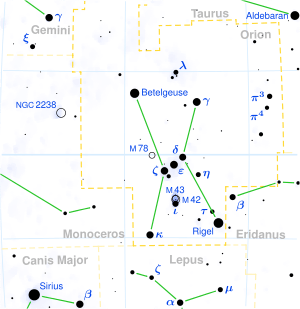HD 37756
| Observation data Epoch J2000 Equinox J2000 | |
|---|---|
| Constellation | Orion |
| Right ascension | 05h 40m 50.71498s[1] |
| Declination | −1° 07′ 43.6366″[1] |
| Apparent magnitude (V) | 4.95[2] |
| Characteristics | |
| Spectral type | B2IV-V[3] |
| U−B color index | -0.83[4] |
| B−V color index | -0.21[4] |
| Astrometry | |
| Radial velocity (Rv) | +26.10[5] km/s |
| Proper motion (μ) | RA: -1.50[1] mas/yr Dec.: -0.84[1] mas/yr |
| Parallax (π) | 3.63 ± 0.37[1] mas |
| Distance | approx. 900 ly (approx. 280 pc) |
| Absolute magnitude (MV) | -2.74[2] |
| Details | |
| Mass | 8.6[6] M☉ |
| Luminosity | 4830[7] L☉ |
| Temperature | 21,150[7] K |
| Metallicity [Fe/H] | +0.01[8] dex |
| Rotational velocity (v sin i) | 75[9] km/s |
| Other designations | |
| Database references | |
| SIMBAD | data |
HD 37756 is a class B2IV[3] (blue subgiant) star in the constellation Orion. Its apparent magnitude is 4.95[2] and it is approximately 900 light years away based on parallax.[1]
It is a spectroscopic binary, with a period of 27 days and eccentricity 0.72.[10]
References
- 1 2 3 4 5 6 Van Leeuwen, F. (2007). "Validation of the new Hipparcos reduction". Astronomy and Astrophysics. 474 (2): 653. arXiv:0708.1752. Bibcode:2007A&A...474..653V. doi:10.1051/0004-6361:20078357. Vizier catalog entry
- 1 2 3 Anderson, E.; Francis, Ch. (2012). "XHIP: An extended hipparcos compilation". Astronomy Letters. 38 (5): 331. arXiv:1108.4971. Bibcode:2012AstL...38..331A. doi:10.1134/S1063773712050015. Vizier catalog entry
- 1 2 Hoffleit, D.; Warren, W. H. (1995). "VizieR Online Data Catalog: Bright Star Catalogue, 5th Revised Ed. (Hoffleit+, 1991)". VizieR On-line Data Catalog: V/50. Originally published in: 1964BS....C......0H. 5050. Bibcode:1995yCat.5050....0H.
- 1 2 Mallama, A. (2014). "Sloan Magnitudes for the Brightest Stars". The Journal of the American Association of Variable Star Observers. 42: 443. Bibcode:2014JAVSO..42..443M. Vizier catalog entry
- ↑ Wilson, R. E. (1953). General Catalogue of Stellar Radial Velocities. Carnegie Institution for Science. Bibcode:1953GCRV..C......0W. LCCN 54001336.
- ↑ Tetzlaff, N.; Neuhäuser, R.; Hohle, M. M. (2011). "A catalogue of young runaway Hipparcos stars within 3 kpc from the Sun". Monthly Notices of the Royal Astronomical Society. 410: 190. arXiv:1007.4883. Bibcode:2011MNRAS.410..190T. doi:10.1111/j.1365-2966.2010.17434.x. Vizier catalog entry
- 1 2 Hohle, M.M.; Neuhäuser, R.; Schutz, B.F. (2010). "Masses and luminosities of O- and B-type stars and red supergiants". Astronomische Nachrichten. 331 (4): 349. arXiv:1003.2335. Bibcode:2010AN....331..349H. doi:10.1002/asna.200911355. Vizier catalog entry
- ↑ Gontcharov, G. A. (2012). "Dependence of kinematics on the age of stars in the solar neighborhood". Astronomy Letters. 38 (12): 771. arXiv:1606.08814. Bibcode:2012AstL...38..771G. doi:10.1134/S1063773712120031. Vizier catalog entry
- ↑ Abt, Helmut A.; Levato, Hugo; Grosso, Monica (2002). "Rotational Velocities of B Stars". The Astrophysical Journal. 573: 359. Bibcode:2002ApJ...573..359A. doi:10.1086/340590.
- ↑ Rao, N. Kameswara; Ashoka, B. N.; Lloyd, C.; Pike, C. D.; Stickland, D. J. (1990). "The eccentric double-lined binary BD — 1° 1004". Journal of Astrophysics and Astronomy. 11 (4): 445. Bibcode:1990JApA...11..445K. doi:10.1007/BF02709760.
This article is issued from
Wikipedia.
The text is licensed under Creative Commons - Attribution - Sharealike.
Additional terms may apply for the media files.
